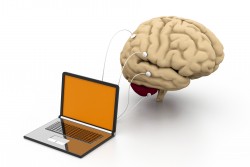Autism-Aspergers
Can Neurofeedback Help with Autism Spectrum Disorder?
 Neurofeedback training has been used by hundreds of clinicians to help thousands of children on the autistic spectrum from Asperger’s to full-blown autism. Several research studies have also been published to support these efforts.
Neurofeedback training has been used by hundreds of clinicians to help thousands of children on the autistic spectrum from Asperger’s to full-blown autism. Several research studies have also been published to support these efforts.
Parents consistently report that as their children begin brain training, they are calmer, manage emotions better, and don’t get overwhelmed as easily. There are many other positive changes which occur, as listed below, but these are typically the first improvements witnessed.
Research Shows Significant Symptom Improvement with Neurofeedback
The research indicates neurofeedback reduces symptoms associated with Autism Spectrum Disorder (ASD). The most important study published so far is called “Assessment-Guided Neurofeedback for Autistic Spectrum Disorder,” and included 37 Autistic Spectrum Disorder children. It was conducted by Dr. Robert Coben, a well-respected neuropsychologist from New York, and his colleague Dr. Ilean Padolsky.
The results of this study showed improved ratings of ASD symptoms for 89% of the experimental group, as reported by parents – based on the ATEC scale (from the Autism Research Institute). The ATEC rating scale included symptoms covering:
- Speech/Language/Communication, (14items)
- Sociability (20 items)
- Sensory/CognitiveAwareness (18 items)
- Health/Physical/Behavior (25 items).
How Does Neurofeedback Help?
 Neurofeedback uses biofeedback technology to establish healthier brain patterns. With ASD, the brain is dysregulated. Studies indicate that individuals with ASD have excessive connectivity in some areas of the brain and deficient connectivity in others.
Neurofeedback uses biofeedback technology to establish healthier brain patterns. With ASD, the brain is dysregulated. Studies indicate that individuals with ASD have excessive connectivity in some areas of the brain and deficient connectivity in others.
Neurofeedback is a very effective way of stabilizing and regulating brain function. By facilitating improvement in areas of abnormal connectivity and improving the functioning of the brain, symptoms are reduced, and positive outcomes result.
What Improvements Have Been Noted with Neurofeedback in ASD?
- Initiation of touch and contact

- Reduced emotional outbursts
- Slower, clearer speech patterns
- Better responses to parental and teacher instructions
- Less ritualistic and more imaginative thought
- Increased tolerance to change
- Decreased hyperactivity & impulsivity
- Heightened levels of focus and attention
- Diminished anxiety
- Better social skills and enhanced relationships
- Increased stability and calmness
- Heightened awareness of feelings and emotions
A Better Way to Change the Brain without Medication
With medication, and even supplements, benefits usually disappear when the treatment is stopped. Improvements resulting from neurofeedback extend beyond the training period, yielding sustainable outcomes. For long-lasting change to occur, the brain must learn healthier patterns. Once the new brain pattern has been learned through neurofeedback training, the individual tends not to forget (we don’t usually forget how to ride a bike once that skill has been well learned). Unlike medication, neurofeedback has no side effects.
Neurofeedback: A Powerful Tool in the Treatment of Autism
 Neurofeedback improves the quality of life for both people with ASD and their families. It not only improves cortical function, but also teaches self-regulation. It has no long-term side effects and offers sustainable results. By combining neurofeedback with a comprehensive bio-psychosocial approach, people have a good chance of improving areas of dysfunction.
Neurofeedback improves the quality of life for both people with ASD and their families. It not only improves cortical function, but also teaches self-regulation. It has no long-term side effects and offers sustainable results. By combining neurofeedback with a comprehensive bio-psychosocial approach, people have a good chance of improving areas of dysfunction.
We also encourage clients to learn how to combine nutritional, diet, and metabolic support with neurofeedback, so that the brain is in the best position for optimum learning.
Examples Of Neurofeedback and Clients with ASD
6-year-old autistic boy, very hyperactive, extremely limited speech.
Since starting neurofeedback, the first thing the mom reported was that he became very “chatty”, though much of the speech initially was unintelligible or at just very limited words. As training increased, he became much more calm. He can sit still for much longer periods of time. He is continuing to speak more in context and in response to what it going on around him. His teachers are reporting he is doing “awesome” in school, really paying attention, and learning better.
Video: 6-year-old Autistic boy using Neurofeedback.
Play Video Interview with Darlene, his mom, who was referred for neurofeedback by his Occupational Therapist.
She reports “the benefits outweighed any other therapies we’ve done.” She reported that he’s become more relaxed and more verbal. He’s more social, interacting with others in ways she never thought he could do, and more conversational. Created by EEGinfo.
8-year-old autistic boy in a special school.
After 1 year of training with neurofeedback, here are some of the changes reported:
- Medications have been reduced by half.
- Increasingly expresses ideas and asks questions.
- Speech was previously too rapid to understand, but is now slower and more distinct.
- Loud outbursts are now infrequent and much less intense.
- Asks for hugs and will initiate touch.
- Interacts with siblings and can do some group work at school for the first time.
- Responds more appropriately to parental directions.
- Has improved balance and gross motor control.
- Tolerates changes in his environment better than before.
- Mood is more stable and positive.
> Courtesy of EEG Spectrum
To learn more about how neurofeedback can help you or your family with Autistic Spectral disorder or Asperger’s, please visit our Neurofeedback Provider List to see if we have a clinician listed near you.

